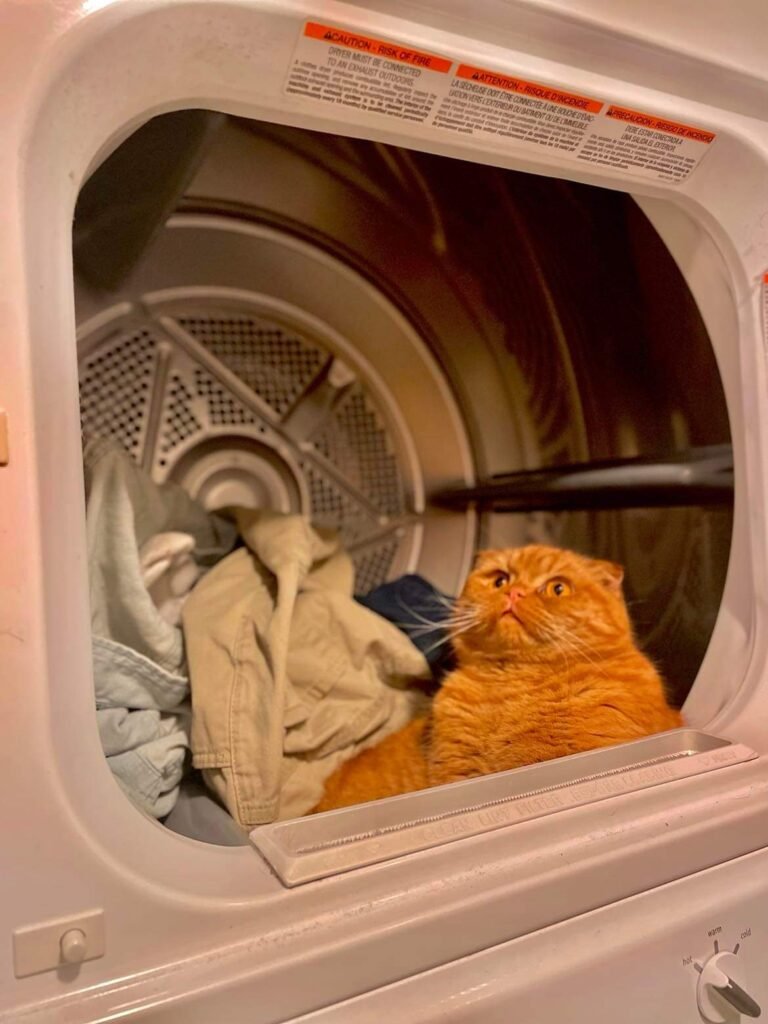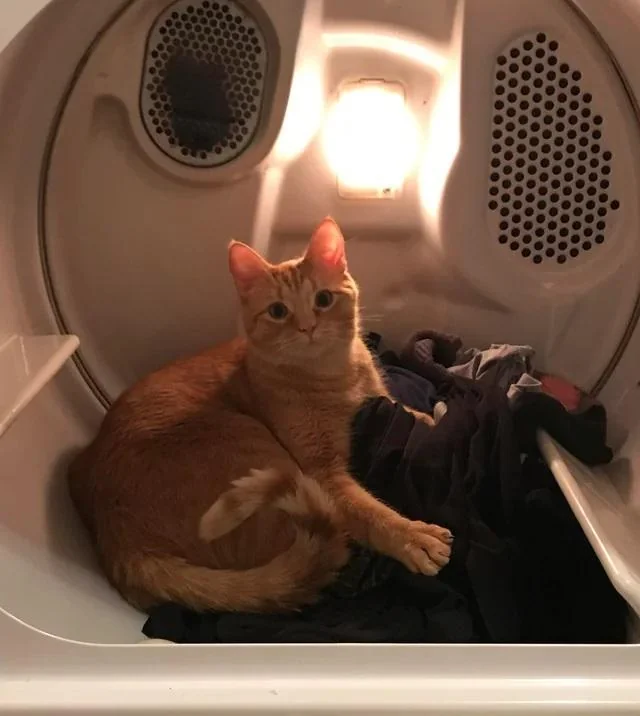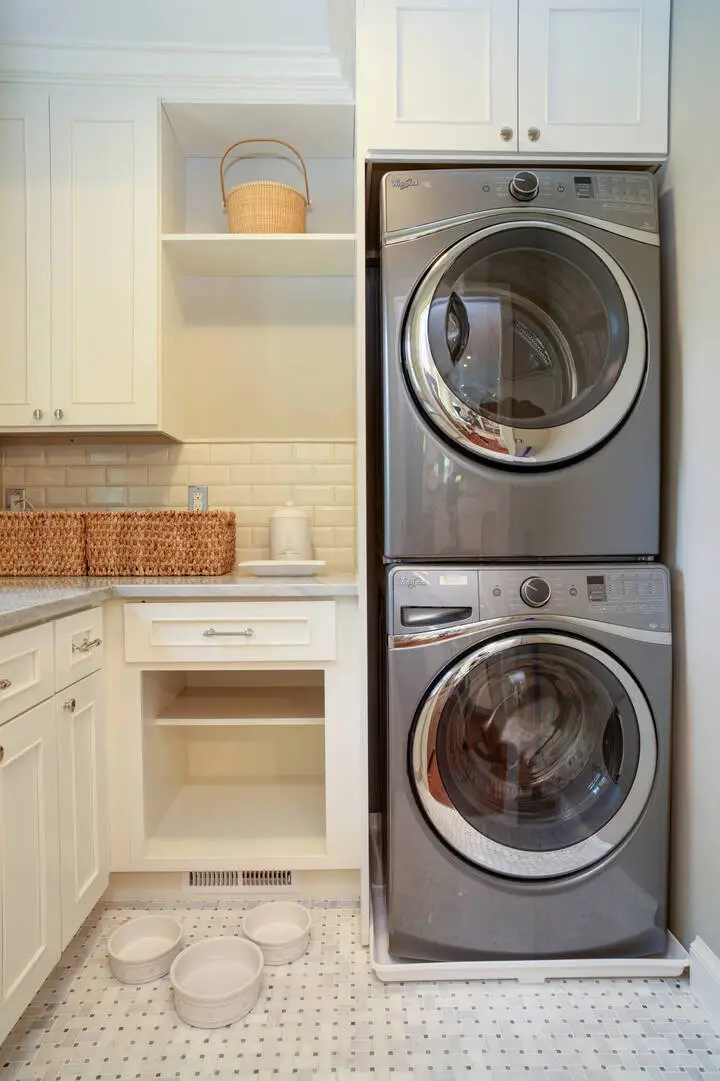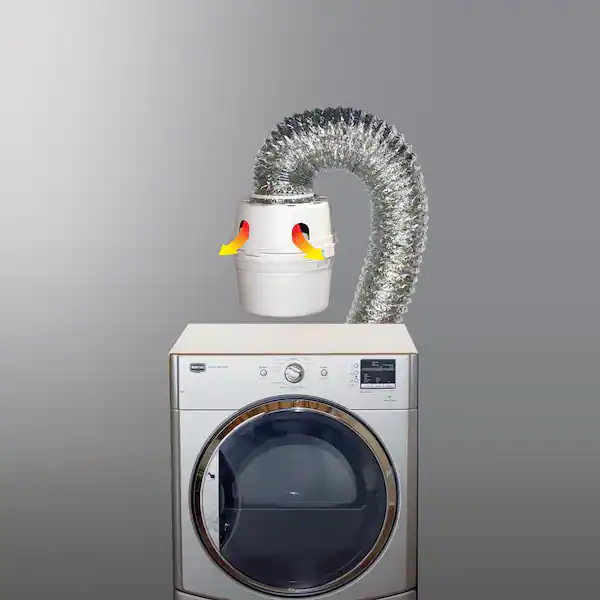The Cat in Dryer: A Feline Misadventure
Imagine the chaos that ensues when curiosity gets the better of our beloved feline friends. Cats, known for their playful and inquisitive nature, sometimes find themselves in peculiar situations. One such scenario that cat owners often encounter is the infamous cat in dryer predicament. In this article, we will delve into the comical yet concerning situation of a cat exploring the confines of a dryer. We will explore why cats are drawn to dryers, the risks involved, and how to prevent such incidents. Let’s embark on this curious adventure!
Why is my cat in the dryer?
The cat is in the dryer because of the Allure of the Dryer that represents the warmth and coziness and the hidden world.
The Warmth and Coziness
Cats are naturally drawn to warm and cozy spots, and a clothes dryer, especially right after a cycle, provides the perfect environment. The residual warmth and softness of the freshly dried clothes mimic a comfortable nest for a cat to curl up in.
The Hidden World
The dryer is an enclosed space with a rotating drum, making it inherently appealing to a cat’s hunting instincts. Cats are curious creatures, and they are often intrigued by the idea of exploring what lies behind closed doors, even if it’s just a laundry room appliance.
what are The Dangers of a Cat in Dryer?
What happens if cat gets in dryer?
Entrapment
One of the most immediate dangers of a cat in a dryer is the risk of entrapment. If a cat crawls into the drum and the door is shut without the owner’s knowledge, it can lead to disastrous consequences when the dryer is turned on.
Tumbling and Injury
Should the dryer be turned on with the cat inside, the feline may be subjected to the spinning and tumbling of the drum. This can result in severe injuries or even prove fatal.
Heat Exposure
The warmth that initially attracts cats to dryers can quickly become life-threatening if the machine is activated. Cats can overheat, leading to heatstroke or burns.

What is the definition of dryer safety for pets?
Dryer safety for pets refers to the set of precautions and practices aimed at ensuring the well-being and protection of pets, particularly cats and small dogs, when it comes to household clothes dryers. This includes:
Preventing Access
The primary aspect of dryer safety for pets is making sure that pets cannot enter the dryer while it is in use or when the door is open. This involves measures such as keeping the laundry room door closed and using childproof locks to secure it.
Vigilance
Pet owners should always be vigilant when using the dryer. This means checking inside the drum and around the laundry area before starting a cycle to ensure no pet is hiding or seeking warmth inside.
Providing Alternatives
To deter pets from exploring dryers for warmth, pet owners can provide alternative cozy spots for their pets. These can include heated pet beds, blankets, or warm, comfortable areas in the home where pets can rest comfortably.
Immediate Action
In the event of a pet being discovered inside the dryer, it’s crucial to take immediate action. This includes stopping the dryer, opening the door, and checking on the pet’s condition. If there are any signs of distress or injury, seeking immediate veterinary attention is essential.
Education
Pet owners should educate themselves and their family members about the potential dangers of pets in dryers. Awareness can help prevent accidents.
In summary, dryer safety for pets involves creating a safe environment for pets in the laundry area, being attentive to their whereabouts, and taking swift action to protect them from the potential hazards associated with dryers. It is a responsible practice that ensures the safety and well-being of our furry friends.
Did the cat survive the dryer incident?
The outcome of a cat in a dryer largely depends on the prompt actions taken by the owner. If the dryer is stopped immediately upon realizing the cat is inside, and the cat is unharmed, then the cat may survive the incident. However, if the dryer is not stopped promptly, or if the cat sustains injuries during the tumble or from the heat, it could lead to severe harm or even a tragic outcome.
How to Prevent a Cat-in-Dryer Scenario?
Vigilance
The key to preventing a cat from getting into the dryer is vigilance. Always check the dryer before closing the door and starting a cycle. Make it a habit to count your cats to ensure they are not hiding inside.
Secure the Laundry Room
Install a childproof lock on the laundry room door to prevent cats from entering unsupervised. This simple measure can go a long way in keeping your furry friends safe.
Provide Alternative Warm Spots
If your cat is drawn to the warmth of the dryer, consider providing alternative cozy spots in your home, like heated pet beds or blankets.
Why is my cat peeing in the dryer?
Cats may pee in the dryer for several reasons, and understanding the underlying cause can help you address and prevent this behavior. Here are some common reasons why a cat may choose to urinate in a dryer:
- Medical Issues: The first step when a cat exhibits unusual urination behavior is to rule out any underlying medical problems. Cats may urinate outside the litter box if they have urinary tract infections, bladder issues, kidney problems, or other health concerns. Consult with your veterinarian to conduct a thorough health check for your cat.
- Stress or Anxiety: Cats are sensitive animals, and stress or anxiety can trigger inappropriate urination. Changes in their environment, such as a new pet, a move to a new home, or changes in routine, can lead to stress-related behaviors. Providing a calm and stable environment, as well as offering hiding spots and vertical space for your cat, can help reduce stress.
- Litter Box Issues: Cats are particular about their litter boxes. If the litter box is dirty, too small, or located in an inconvenient or noisy area, a cat may seek alternative places to urinate. Ensure that the litter box is clean, the right size, and placed in a quiet, accessible location.
- Territorial Marking: Unspayed or unneutered cats are more likely to engage in territorial marking behavior. This involves urinating in different areas of the home, including appliances like the dryer, to establish territory or communicate with other cats. Spaying or neutering your cat can reduce this behavior.
- Behavioral Issues: Behavioral problems such as aggression, fear, or dominance can also lead to inappropriate urination. Working with a professional animal behaviorist can help identify and address these issues.
- Environmental Factors: Changes in the home environment, such as the introduction of new furniture, a new person, or even a change in laundry detergents, can disrupt a cat’s routine and lead to stress-related urination issues.
- **Dirty Dryer: ** If the dryer is not clean and has traces of old urine or scent markers from previous incidents, it may attract the cat to urinate in it again. Thoroughly clean and sanitize the dryer to remove any lingering odors.
- Exploratory Behavior: Curiosity may lead some cats to investigate and urinate in the dryer out of curiosity, especially if they find it warm and cozy.
To address the issue of your cat urinating in the dryer, it’s essential to identify the specific cause. Consult with your veterinarian to rule out medical issues, and then work on creating a comfortable, stress-free environment for your cat. This may involve behavior modification techniques and making changes to the litter box setup and cleaning routine. In severe cases, consulting with a professional animal behaviorist can provide tailored solutions for your cat’s specific behavior problems.
How do I get cat pee smell out of my dryer?
etting the smell of cat urine out of your dryer can be a challenging but necessary task to ensure your appliance is clean and odor-free. Here’s a step-by-step guide to help you eliminate the cat pee smell from your dryer:
Materials You’ll Need:
- Rubber gloves
- Old towels or paper towels
- White vinegar
- Baking soda
- Mild detergent
- Empty spray bottle
- Soft cloth or sponge
- A well-ventilated area
- Optional: Enzymatic pet stain and odor remover
Steps:
- Safety First: Ensure you have rubber gloves on to protect your hands during the cleaning process. Work in a well-ventilated area if possible.
- Remove Any Residue: Using old towels or paper towels, blot and remove as much of the urine as possible from the dryer drum. Dispose of the soiled materials properly.
- Prepare a Cleaning Solution:
- Mix equal parts white vinegar and water in an empty spray bottle. This solution is effective at neutralizing odors.
- Alternatively, you can use an enzymatic pet stain and odor remover, following the product’s instructions.
- Spray and Wipe: Spray the vinegar and water solution or the enzymatic cleaner inside the dryer drum, focusing on areas where the urine was present. Allow it to sit for 10-15 minutes to break down the odor.
- Scrub Gently: Use a soft cloth or sponge dampened with the cleaning solution to gently scrub the affected areas inside the dryer drum. Avoid abrasive materials that could damage the drum’s finish.
- Rinse Thoroughly: Wipe down the drum with a clean, damp cloth to remove any residue from the cleaning solution. Rinse the cloth frequently.
- Dryer Cycle: To further eliminate odors and ensure that the dryer is safe to use, run an empty dryer cycle on the highest heat setting for about 30 minutes. This will help to remove any remaining odor and moisture.
- Check Ventilation: Ensure that the dryer’s ventilation system is clean and free of any urine residue. Clean or replace the vent if necessary to prevent odors from being recirculated.
- Repeat If Necessary: If the odor persists after the first cleaning, you may need to repeat the cleaning process, focusing on stubborn areas.
- Prevent Future Incidents: To prevent cats from urinating in the dryer in the future, follow the preventative measures mentioned earlier in this conversation, such as securing the laundry room and addressing any underlying behavioral or environmental issues.
By following these steps, you can effectively remove the cat pee smell from your dryer and ensure that it is clean and safe to use.
Conclusion
In conclusion, the cat in dryer scenario is a potentially dangerous situation that cat owners should be aware of. Cats’ natural curiosity and love for warm, enclosed spaces make dryers an attractive yet perilous option for exploration. To keep your feline friend safe, always be vigilant, secure your laundry room, and offer alternative cozy spots. Remember, ensuring your cat’s safety is of utmost importance.
FAQ cat in dryer
1. Can cats really fit inside a dryer?
Yes, cats can often fit into dryer drums, especially smaller breeds. Their flexible bodies allow them to squeeze into tight spaces.
2. What should I do if I accidentally turn on the dryer with my cat inside?
Immediately stop the dryer, open the door, and check on your cat. Seek immediate veterinary attention if needed.
3. Are there any warning signs that my cat might be inside the dryer?
Cats may hide in the laundry or show interest in the dryer. Always check before starting the machine.
4. Can I use the dryer while my cat is in the room?
It’s not recommended to use the dryer when your cat is in the same room, as they may be tempted to explore it.
5. Are there any cat-safe alternatives to dryers for warmth?
Yes, heated pet beds and blankets are excellent alternatives to keep your cat warm and cozy without the risks associated with dryers.
6. Can my cat sleep in the dryer?
No, While it may seem cozy to your cat but it’s highly discouraged to let your cat sleep in the dryer. Dryers have moving parts and can be turned on accidentally, posing serious risks to your cat’s safety. It’s always safer to provide alternative, cat-friendly sleeping spots in your home.
7. Can a cat get stuck in a dryer vent?
Yes, cats can potentially get stuck in a dryer vent. Dryer vents are typically narrow and can lead to hazardous situations if a cat enters them. It’s crucial to regularly inspect and secure your dryer vent to prevent your cat from accessing it. If you suspect your cat is stuck in a dryer vent, seek professional assistance immediately to safely rescue your pet and address any potential injuries.







